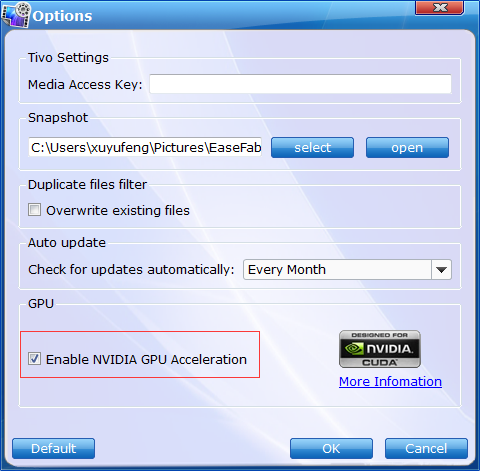I don’t know exactly when HandBrake added the capability of using the GPU for encoding, but it was somewhere between 1.3.1 (current version in the Ubuntu repositories) and 1.3.3 (current version on PPA). Regardless, this option offers dramatic speed improvements, particularly when working with 4K videos. In this post, I’ll show how to use this feature in Handbrake and show some comparisons to illustrate the benefits and tradeoffs that result.
But, ffmpeg has supported GPU acceleration,including nvenc (Nvidia) and QSV (Intel), but the current version of HandBrake doesn’t support NVENC, and it can’t support QSV very well. That is because Handbrake doesn’t use ffmpeg but libav and NVENC hasn’t release of libav yet. Handbrake team said they didn’t have the plan to add NVENC. Additional Handbrake cuda acceleration selection Movavi Video Converter Whenever we need to change the format of any of our video or audio files to enjoy them on a different device, all we usually want is a simple converter capable of transcoding all our files in one.
How to Use NVENC GPU Encoding
First, make sure you have the latest version of Handbrake installed (as of 6/26/2020 that is version 1.3.3). Also, to use Nvenc encoding, you’ll need the Nvidia Graphics Driver 418.81 or later and an Nvidia GeForce GTX 1050+ series GPU or better per HandBrake’s documentation. I’m using a GTX 1060 and have Driver version 440.100 installed. My CPU is an AMD Ryzen 5 3600 6-Core, 12-Thread processor.
The video I’m using to illustrate how to use GPU encoding is a Blu-Ray rip of Pan’s Labyrinth. I’m making a backup copy of the video to store on my file server. I used MakeMKV to pull the video off the BluRay disc, resulting in a 31.7GB file. I’m going to convert that to a 1080p H265 video file that is substantially smaller in size.
Open up HandBrake and load your file you want to convert by clicking on “Open Source.” Find the file you want to convert and select “Open.”
HandBrake will run through the file, gathering information about the codec, subtitles, audio tracks, etc. Once it’s done, you’ll need to select what format you want to convert it to. For this tutorial, I’m just going to use a General Preset, but I want to illustrate the difference in encoding speed, so I’m going to select Super HQ 1080p30 Surround rather than Fast 1080p30.
To change from CPU encoding to GPU encoding, click on the Video tab:

In the middle of the screen, you’ll see a drop-down menu labeled “Video Encoder.” Click on that drop-down menu and you should see two NVENC options: H.264 (NVenc) and H.265 (NVenc). Those are the two options for using your GPU for the encoding versus using your CPU. The H.265 codec is newer and has somewhat better compression algorithms, but I’m not going to opine as to which of these you should choose. That choice should really be driven by what device you’re going to be playing your videos on. Regardless of which you choose, those two will push the encoding to your GPU instead of your CPU.
Handbrake Gpu Acceleration Mac Os
Make sure you’ve adjusted your Audio, Subtitles, and Tags to your preferences, then click “Start.” That’s all there is to it – you now have GPU encoding.
Benchmarks: Encoding Speed
Using the H.265 (NVenc) encoder, it took about 17 minutes to convert the 31.7GB MKV file into a 8.4GB m4v file.
Resharper 10 keygen. You can also see that even using the H.265 (NVenc) encoder, much of the processing is passed to the CPU, as shown in this screenshot that shows my GPU is working, but it’s certainly not being stressed:
Using all the same options but CPU encoding instead, HandBrake took 1 hour and 15 minutes to encode the file, so about 5 times as long.
Here’s the same resource utilization illustration showing that HandBrake is drawing exclusively on the CPU and not the GPU:
Other tests I ran encoding 4K video illustrated that this difference increases with 4K video. I converted one 4K movie that was about 1 hour, 40 minutes using H.265 (NVenc) and it took about 1 hour. Using the CPU alone, HandBrake estimated it would take 18 hours (I didn’t wait to see if that was accurate). Thus, there is a dramatic difference in encoding speed with higher resolution and larger video files.
Benchmarks: Video Size and Quality
What about file size and video quality? I’m probably not going to do justice the differences because I don’t have the most discerning eye for pixellation and resolution differences, but I will try to use some objective measures. The video encoded with the GPU was 8.39GB in size. The video encoded with the CPU was 3.55GB. I’m not exactly sure why the file sizes are so different given that I chose the same setting for both encodes, but this next screenshot illustrates that the NVENC encode resulted in a higher bitrate (9,419 kb/s) versus the CPU encode with a lower bitrate (3,453 kb/s). Strange.
I also wanted to see if I could tell if there was a noticeable difference in quality between the two videos. I navigated to the same scene in both videos and used VLC to take a screenshot. First, the NVENC encoded screenshot:
My 43-year-old eyes don’t see much of a difference at all.
Conclusion
Gpu Acceleration Software
If you’ve got the hardware and want to save time, using GPU encoding with Handbrake is a nice option. The end result is a much faster encode, particularly with higher resolution videos. Some of the forums where I was reading about this option suggested there are problems with using GPU encoding. I certainly won’t challenge those assertions, but I can’t tell the difference.
Handbrake Use Gpu To Encode
40,604 total views, 106 views today
